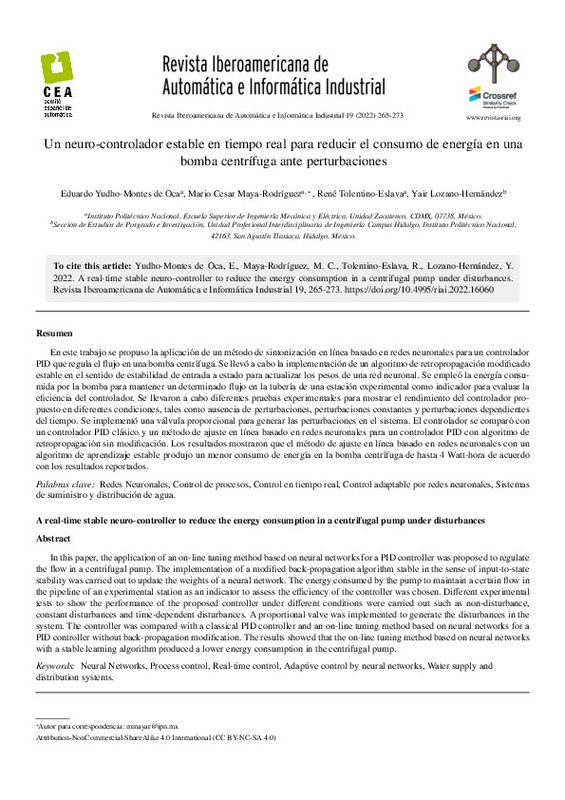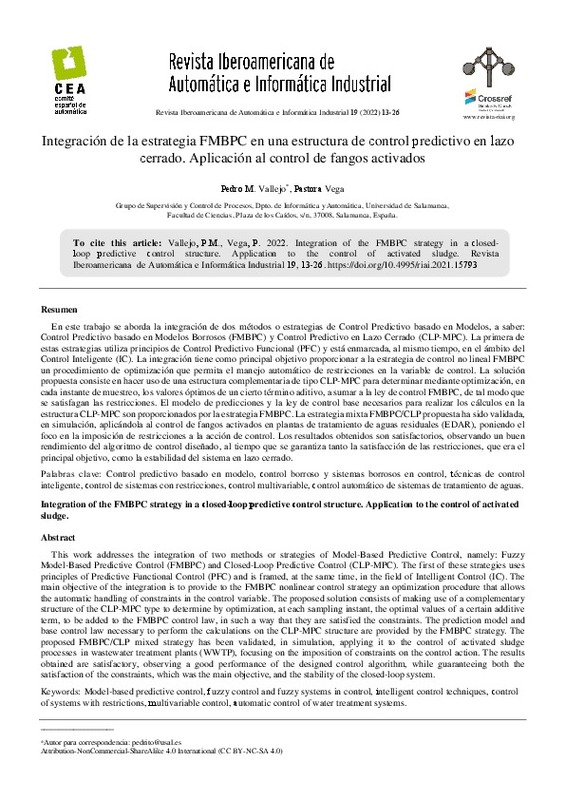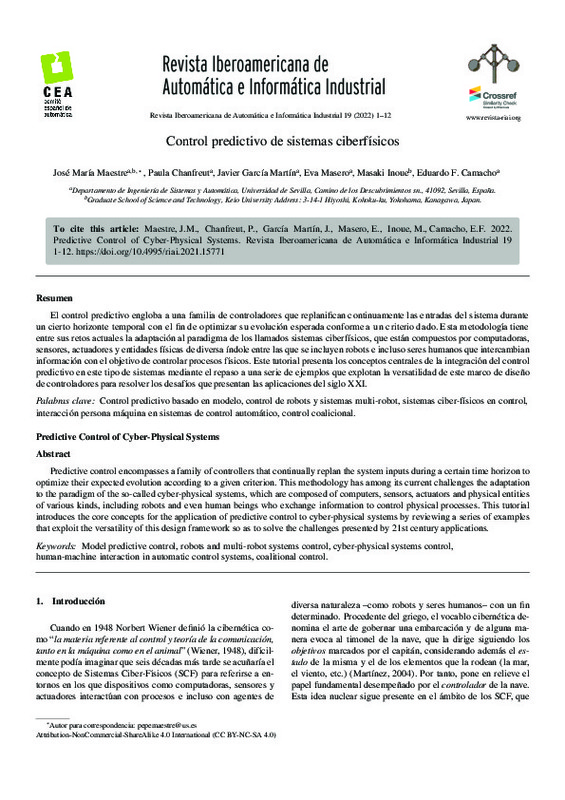JavaScript is disabled for your browser. Some features of this site may not work without it.
Buscar en RiuNet
Listar
Mi cuenta
Estadísticas
Ayuda RiuNet
Admin. UPV
Un neuro-controlador estable en tiempo real para reducir el consumo de energía en una bomba centrífuga ante perturbaciones
Mostrar el registro sencillo del ítem
Ficheros en el ítem
| dc.contributor.author | Yudho-Montes de Oca, Eduardo
|
es_ES |
| dc.contributor.author | Maya-Rodríguez, Mario Cesar
|
es_ES |
| dc.contributor.author | Tolentino-Eslava, René
|
es_ES |
| dc.contributor.author | Lozano-Hernández, Yair
|
es_ES |
| dc.date.accessioned | 2022-10-04T12:24:16Z | |
| dc.date.available | 2022-10-04T12:24:16Z | |
| dc.date.issued | 2022-06-29 | |
| dc.identifier.issn | 1697-7912 | |
| dc.identifier.uri | http://hdl.handle.net/10251/186924 | |
| dc.description.abstract | [EN] In this paper, the application of an on-line tuning method based on neural networks for a PID controller was proposed to regulate the flow in a centrifugal pump. The implementation of a modified back-propagation algorithm stable in the sense of input-to-state stability was carried out to update the weights of a neural network. The energy consumed by the pump to maintain a certain flow in the pipeline of an experimental station as an indicator to assess the efficiency of the controller was chosen. Different experimental tests to show the performance of the proposed controller under different conditions were carried out such as non-disturbance, constant disturbances and time-dependent disturbances. A proportional valve was implemented to generate the disturbances in the system. The controller was compared with a classical PID controller and an on-line tuning method based on neural networks for a PID controller without back-propagation modification. The results showed that the on-line tuning method based on neural networks with a stable learning algorithm produced a lower energy consumption in the centrifugal pump. | es_ES |
| dc.description.abstract | [ES] En este trabajo se propuso la aplicacion de un método de sintonización en línea basado en redes neuronales para un controlador PID que regula el flujo en una bomba centrífuga. Se llevo a cabo la implementación de un algoritmo de retropropagación modificado estable en el sentido de estabilidad de entrada a estado para actualizar los pesos de una red neuronal. Se empleó la energía consumida por la bomba para mantener un determinado flujo en la tuber´ía de una a estación experimental como indicador para evaluar la eficiencia del controlador. Se llevaron a cabo diferentes pruebas experimentales para mostrar el rendimiento del controlador propuesto en diferentes condiciones, tales como ausencia de perturbaciones, perturbaciones constantes y perturbaciones dependientes del tiempo. Se implementó una v´álvula proporcional para generar las perturbaciones en el sistema. El controlador se comparó con un controlador PID clasico y un método de ajuste en línea basado en redes neuronales para un controlador PID con algoritmo de retropropagacion sin modificación. Los resultados mostraron que el método de ajuste en línea basado en redes neuronales con un algoritmo de aprendizaje estable produjo un menor consumo de energía en la bomba centrífuga de hasta 4 Watt-hora de acuerdo con los resultados reportados. | es_ES |
| dc.language | Español | es_ES |
| dc.publisher | Universitat Politècnica de València | es_ES |
| dc.relation.ispartof | Revista Iberoamericana de Automática e Informática industrial | es_ES |
| dc.rights | Reconocimiento - No comercial - Compartir igual (by-nc-sa) | es_ES |
| dc.subject | Neural Networks | es_ES |
| dc.subject | Process control | es_ES |
| dc.subject | Real-time control | es_ES |
| dc.subject | Adaptive control by neural networks | es_ES |
| dc.subject | Water supply and distribution systems | es_ES |
| dc.subject | Redes Neuronales | es_ES |
| dc.subject | Control de procesos | es_ES |
| dc.subject | Control en tiempo real | es_ES |
| dc.subject | Control adaptable por redes neuronales | es_ES |
| dc.subject | Sistemas de suministro y distribucion de agua | es_ES |
| dc.title | Un neuro-controlador estable en tiempo real para reducir el consumo de energía en una bomba centrífuga ante perturbaciones | es_ES |
| dc.title.alternative | A real-time stable neuro-controller to reduce the energy consumption in a centrifugal pump under disturbances | es_ES |
| dc.type | Artículo | es_ES |
| dc.identifier.doi | 10.4995/riai.2022.16060 | |
| dc.rights.accessRights | Abierto | es_ES |
| dc.description.bibliographicCitation | Yudho-Montes De Oca, E.; Maya-Rodríguez, MC.; Tolentino-Eslava, R.; Lozano-Hernández, Y. (2022). Un neuro-controlador estable en tiempo real para reducir el consumo de energía en una bomba centrífuga ante perturbaciones. Revista Iberoamericana de Automática e Informática industrial. 19(3):265-273. https://doi.org/10.4995/riai.2022.16060 | es_ES |
| dc.description.accrualMethod | OJS | es_ES |
| dc.relation.publisherversion | https://doi.org/10.4995/riai.2022.16060 | es_ES |
| dc.description.upvformatpinicio | 265 | es_ES |
| dc.description.upvformatpfin | 273 | es_ES |
| dc.type.version | info:eu-repo/semantics/publishedVersion | es_ES |
| dc.description.volume | 19 | es_ES |
| dc.description.issue | 3 | es_ES |
| dc.identifier.eissn | 1697-7920 | |
| dc.relation.pasarela | OJS\16060 | es_ES |
| dc.description.references | Aggarwal, C., 2018. Neural Networks and Deep Learning. Springer International Publishing. https://doi.org/10.1007/978-3-319-94463-0 | es_ES |
| dc.description.references | Al-Khalifah, M.H., Mcmillan, G., 2012. Control valve versus variable speed drive for flow control. | es_ES |
| dc.description.references | Boutalis, Y., Theodoridis, D., Kottas, T.L., Christodoulou, M., 2014. System identification and adaptive control. https://doi.org/10.1007/978-3-319-06364-5 | es_ES |
| dc.description.references | Chen, J., Huang, T.C., 2004. Applying neural networks to on-line updated pid controllers for nonlinear process control. Journal of Process Control 14, 211 - 230. https://doi.org/10.1016/S0959-1524(03)00039-8 | es_ES |
| dc.description.references | Fujinaka, T., Kishida, Y., Yoshioka, M., Omatu, S., 2000. Stabilization of double inverted pendulum with self-tuning neuro-pid, in: Proceedings of the IEEE-INNS-ENNS International Joint Conference on Neural Networks. IJCNN 2000. Neural Computing: New Challenges and Perspectives for the New Millennium, pp. 345-348 vol. 4. https://doi.org/10.1109/IJCNN.2000.860795 | es_ES |
| dc.description.references | Haykin, S., 2010. Neural Networks and Learning Machines. volume volume. Third ed., Pearson. | es_ES |
| dc.description.references | Hu, K.m., Li, Y.z., Guan, X.m., 2012. Research of the pipe flow measurement and control system based on bp neural networks pid, in: Advances in Technology and Management, Springer Berlin Heidelberg, Berlin, Heidelberg. https://doi.org/10.1007/978-3-642-29637-6_4 | es_ES |
| dc.description.references | Lozano-Hernández, Y., Fr'ıas, O., Lozada-Castillo, N., Juarez, A., 2019. Control algorithm for taking off and landing manoeuvres of quadrotors in open navigation environments. International Journal of Control Automation and Systems 17, 2331-2342. https://doi.org/10.1007/s12555-017-0743-5 | es_ES |
| dc.description.references | Marchi, A., Simpson, A., Ertugrul, N., 2012. Assessing variable speed pump efficiency in water distribution systems. Drinking Water Engineering and Science 5, 15-21. https://doi.org/10.5194/dwes-5-15-2012 | es_ES |
| dc.description.references | Miroslav, C., Stefan, K., 2003. Neural networks for real time control systems. IFAC Proceedings Volumes 36, 135 - 142. 2nd IFAC Conference on Control Systems Design, Bratislava, Slovak Republic, 7-10 September 2003. https://doi.org/10.1016/S1474-6670(17)34658-X | es_ES |
| dc.description.references | Narendra, K.S., Parthasarathy, K., 1991. Gradient methods for the optimization of dynamical systems containing neural networks. IEEE Transactions on Neural Networks 2, 252-262. https://doi.org/10.1109/72.80336 | es_ES |
| dc.description.references | Nault, J., Papa, F., 2015. Lifecycle assessment of a water distribution system pump. Journal of Water Resources Planning and Management 141. https://doi.org/10.1061/(ASCE)WR.1943-5452.0000546 | es_ES |
| dc.description.references | Nourbakhsh, S.A., Jaumotte, B.A., Hirsch, C., Parizi, H., 2010. Turbopumps and pumping systems. | es_ES |
| dc.description.references | Ogata, K., 2010. Ingeniería de control moderna, Pearson. | es_ES |
| dc.description.references | Pirabakaran, K., Becerra, V., 2002. Pid autotuning using neural networks and model reference adaptive control. IFAC Proceedings Volumes 35, 451 - 456.15th IFAC World Congress. https://doi.org/10.3182/20020721-6-ES-1901.00728 | es_ES |
| dc.description.references | Ramos-Velasco, L.E., Domínguez-Ramírez, O.A., Parra-Vega, V., 2016. Wavenet fuzzy pid controller for nonlinear mimo systems: Experimental validation on a high-end haptic robotic interface. Applied Soft Computing 40, 199-205. doi:10.1016/j.asoc.2015.11.014. https://doi.org/10.1016/j.asoc.2015.11.014 | es_ES |
| dc.description.references | Sarbu, I., Valea, E., 2015. Energy savings potential for pumping water in districtheating stations. Sustainability 7, 1-15. https://doi.org/10.3390/su7055705 | es_ES |
| dc.description.references | Sedighizadeh, M., Rezazadeh, A., 2008. Adaptive pid control of wind energy conversion systems using rasp1 mother wavelet basis function networks. International Journal of Electrical and Computer Engineering , 62-66. URL: https://publications.waset.org/vol/13, doi:doi.org/10.5281/zenodo.1077309. | es_ES |
| dc.description.references | Singh, A., Kaur, A., 2014. Tuning techniques of pid controller: A review, in: National Conference on Advances in Engineering and Technology of International Journal of Engineering Research and Applications. | es_ES |
| dc.description.references | Waide, P., Brunner, C., 2011. Energy-efficiency policy opportunities for electric motor-driven systems. | es_ES |
| dc.description.references | Xi-fan, Y., 2009. Application of self-tuning of pid control based on bp neural networks in the manufacturing process. Modular Machine Tool and Automatic Manufacturing Technique . | es_ES |
| dc.description.references | Yang, Y., Wu, Q., 2016. A neural network pid control for ph neutralization process, in: 2016 35th Chinese Control Conference (CCC), pp. 3480-3483. https://doi.org/10.1109/ChiCC.2016.7553893 | es_ES |
| dc.description.references | Yu, W., Li, X., 2003. Discrete-time neuro identification without robust modification. IEE Proceedings - Control Theory and Applications 150, 311-316. https://doi.org/10.1049/ip-cta:20030204 | es_ES |











